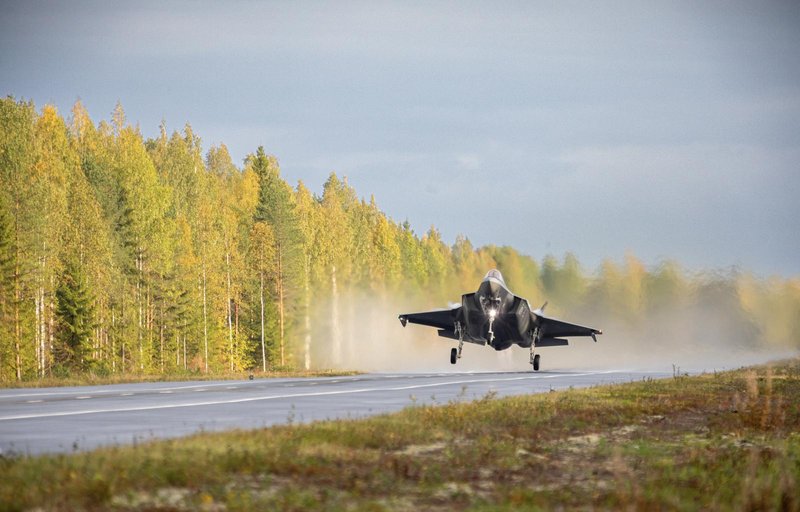Why dispersed aircraft operations are the road less travelled
Among the many defence concepts and trends highlighted by the conflict in Ukraine is the vulnerability of large-scale military infrastructure. Initially Russian but increasingly now Ukrainian strikes on headquarters, logistics centres and bases have become a major element of the war.
The almost continuous operation of UAVs has meant that both sides can know when opposing forces are present in various locations, and hence the most effective time to strike... Continues below
Newsletter Sponsors:

Above: This large expanse of concrete is indicative of the facilities needed to operate a Tu-22, but Russia may need to consider some form of dispersal of its bomber fleet if Ukrainian attacks on air bases continue. (Photo: Russian MoD)
Given their need for extensive ground support and vulnerability to even slight damage, aircraft are a particularly suitable target for long-range weapons, an issue increasingly faced by Russia as its bomber force takes small but frequent casualties on the ground.

The size of a Tu-22M or similar aircraft means that it is extremely difficult for it to be operated outside of a large and well-equipped base. Even the smaller Sukhoi Su-34s, which were designed for somewhat austere operations, are difficult to keep in flying condition without the facilitates of a larger airfield.
Last month the Norwegian Air Force sortied an F-35A from a major road as part of an effort to introduce the platform to the force’s concept of dispersed operations away from existing airfields. In the demo, two aircraft landed on a highway in Finland and then took off again.
This was regarded as a step towards the use of non-traditional facilities which has a strong tradition in Scandinavia. However, it was in many ways a very limited effort and the force and aircraft have a long way to go.
Using wide, straight roads as runways goes back to the Second World War and while by no means simple it is not, for a basic landing and take-off, particularly difficult. What is far more complicated is the notion of actual operations from such a location, and that will likely prove a long and testing process.
In the case of the Norwegian F-35, the aircraft did not linger, the engine was not switched off nor was any refuelling, rearming or similar attempted. For such efforts to translate into operations, clearly a lot more work would have to be undertaken.

Aircraft will have to be refurbished, cleaned, repaired and tested. Large quantities of spares and supplies must be transported for both the platforms themselves and the ground crews based in such an austere location.
Furthermore, significant mobile power generation would be required and everything would have to be organised so that the entire facility could be packed up and moved at very short notice. And finally, a strong but mobile air and land defence would have to be organised.
Neighbouring militaries such as the Swedish Air Force – which is famous for operating its Gripens and other aircraft from forest clearings – were politely amused. This was not what would constitute for them actual operations, but more akin to a publicity stunt.
The Norwegians would – and likely did – respond that they had to start somewhere, and they are not novices at the concept. But clearly they have a way to go before their F-35 units can be considered ready for sustained operations away from major bases.
Russia meanwhile has made various efforts to reduce the vulnerability of its aircraft, the most recent being the curious stacking of tyres on the wings to reduce their signature to guided weapons.

One area in which it has seemed to have made little effort is the use of non-traditional basing for the majority of aircraft. As mentioned above, this is partially due to the difficulties of maintaining strategic bombers without access to the facilities at their home bases. But in more general terms this does not seem to have been a priority, despite Ukraine’s increasingly sophisticated arsenal of long-range strike weapons.
At present, it could well be that the opportunity cost of disrupting air operations is considered too high, but should Ukrainian commanders continue their successful attacks on air force and other installations, a new approach to basing may become an urgent requirement.

Above:Taking off and landing on a forest highway is not a dispersed operation in itself, but this activity is a necessary first step towards such a capability for Norway’s F-35 fleet. (Photo: Norwegian Armed Forces)
As noted above, while Norway’s experiments with a touch-and-go do not qualify as a dispersed operation, they are a vital first step. Given the growing European F-35 user group and shared concerns over Russian intensions, other air forces are doubtlessly watching with interest.

Trillium Engineering specializes in the design and production of gimballed imaging systems for manned and unmanned aircraft. See Details
The entry of Sweden and Finland into NATO, bringing with them decades of experience in this area, has been welcomed as a significant boost to the alliance’s corporate knowledge.
The well-known complexity and relatively delicate constitution of the F-35 means that it will likely never challenge a Gripen or F/A-18 for rough living, but if naval and marine corps aviators can make the aircraft work off-base then ‘A’-model operators should be confident that with a little help and experimentation they also can sever some of the apron strings that have traditionally kept them tied to major infrastructure.
View next article: Airborne early warning and electronic warfare: can modern fighters do it for themselves?
Don't want to miss out on future Decisive Edge content? Make sure you are signed up to our email newsletters.














